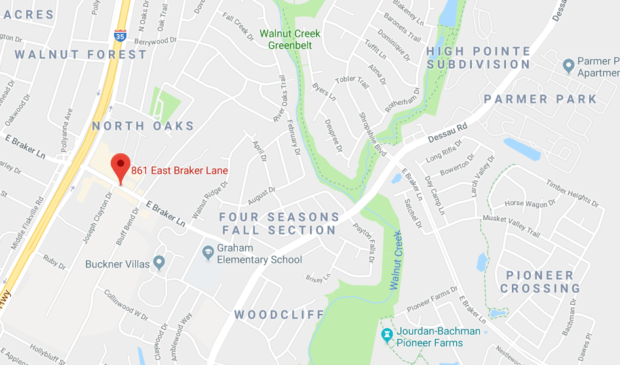North Austin neighborhood group doesn’t want more renters
Tuesday, January 8, 2019 by
Jack Craver A family seeking to sell roughly 30 acres of undeveloped property in North Austin won approval last month from the Zoning and Platting Commission for a zoning change that will allow the land to be developed into over 130 homes, along with some office or retail property.
The recommendation came at the commission’s last hearing of the year on Dec. 18, despite opposition from the Northeast Walnut Creek Neighborhood Association over flooding, traffic and the group’s desire to prevent more rental homes in the area.
The commission did grant one of the association’s wishes: The land will not be allowed to include drug or mental health treatment centers.
The parcel is broken into two pieces on both sides of Wedgewood Drive, fronting Braker Lane. The commission recommended the requested commercial zoning (GR) for 4.5 acres of property fronting Braker and recommended high-density single-family housing (SF-4) for the remaining 25 acres of land. That was the zoning that had been recommended by the city’s Planning and Zoning Department as well.
Speaking on behalf of the neighborhood association was Vanessa Matocha, who had spoken just minutes before against another proposed development in the neighborhood at Braker Lane and Dessau Road.
In her opening remarks, Matocha said that neighbors were worried about the effect a dense development at the top of a hill would have on drainage. Neighbors would prefer large-lot single-family homes instead of townhouses, and they would prefer that the commercial property be limited to low-key uses such as office space or dental practices.
Finally, Matocha asked that if the property is zoned for commercial uses, the commission prohibit a number of uses that the neighbors deemed undesirable, including bail bonds, payday loan stores, pawn shops and residential treatment centers for people receiving mental health or substance abuse treatment.
Matocha recalled that two years ago, the neighborhood association had successfully opposed a behavioral health treatment center proposed by Austin Travis County Integral Care, arguing that it would put children at nearby Graham Elementary in jeopardy. An ATCIC leader at the time described the opposition to the clinic as based on “misinformation” that grew out of the stigma against mental health treatment. Matocha credited former Council Member Ora Houston for helping to scuttle the plan.
Another area homeowner, Raymond Slade, who noted that he was a career hydrologist, said that the city hadn’t mapped a nearby creek and as a result, the property was incorrectly not labeled as being in a flood plain.
In an attempt to address the concerns about flooding, Commissioner Ann Denkler proposed zoning the property for slightly lower-density single-family housing (SF-3). Neither the applicant nor the neighborhood association liked that idea.
Matocha said she believed that SF-3 would be more likely to produce rental homes than the current zoning. Other nearby rental properties had posed problems, she explained, such as “major code violations” and “front yard parking.”
“With ownership comes pride of property,” she said. “With (renting), that doesn’t always apply.”
Matocha said that while she appreciated the gesture by Denkler, “we also worry about pride of homeownership and we are a neighborhood of single-family homes and we would like to keep it that way.”
“I do appreciate your concerns about ownership versus rental,” Denkler said later.
Brent Campbell, a real estate broker representing the parcel’s current owners, said that few homebuilders were interested in developing the property under SF-3 requirements. They needed to be able to build more units, as allowed under SF-4A, to make a profit.
While many builders were interested in building apartment complexes, Campbell said, his clients were not going that route out of respect for the neighbors’ wishes. He emphasized that they were just seeking slightly more density, and that the resulting homes would still be “nice houses” priced around $300,000.
After an hour and a half, the commission ultimately approved the requested zoning, 6-1, with only Chair Jolene Kiolbassa in dissent. Kiolbassa said she was still concerned about the potential for flooding.
The commission’s recommendation will be passed along to City Council, which will have final say over whether the proposed rezoning is approved.
In an interview with the Austin Monitor in January, Commissioner Jim Duncan said he thought the parcel was the “perfect place to get more density and missing middle housing” because of its proximity to Interstate 35. He was also disappointed by the neighborhood association’s attitude about rental units.
“I always hate to hear comments like that,” he said, suggesting the sentiments can reflect a desire for racial or economic segregation.
Duncan said that he sympathized with concerns about code violations and maintenance, but attributed that issue more to absentee landlords. The city needs to do a better job of holding landlords accountable for maintaining their properties, he said, “so that renters aren’t looked at askance.”
On the other hand, he said, “Neighbors need to recognize that rental units can be good neighbors.”
Map courtesy of Google Maps.
The Austin Monitor’s work is made possible by donations from the community. Though our reporting covers donors from time to time, we are careful to keep business and editorial efforts separate while maintaining transparency. A complete list of donors is available here, and our code of ethics is explained here.
You're a community leader
And we’re honored you look to us for serious, in-depth news. You know a strong community needs local and dedicated watchdog reporting. We’re here for you and that won’t change. Now will you take the powerful next step and support our nonprofit news organization?



